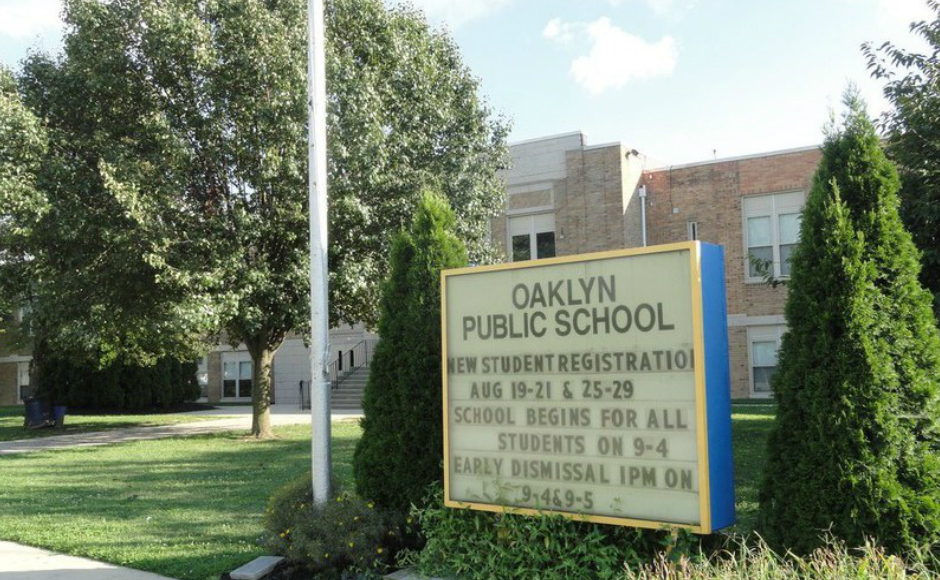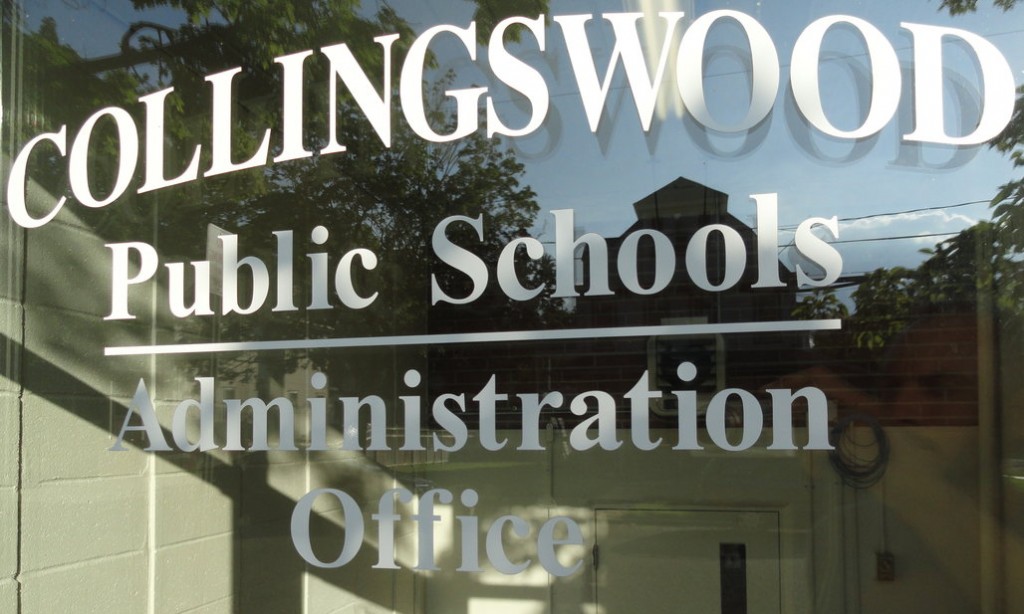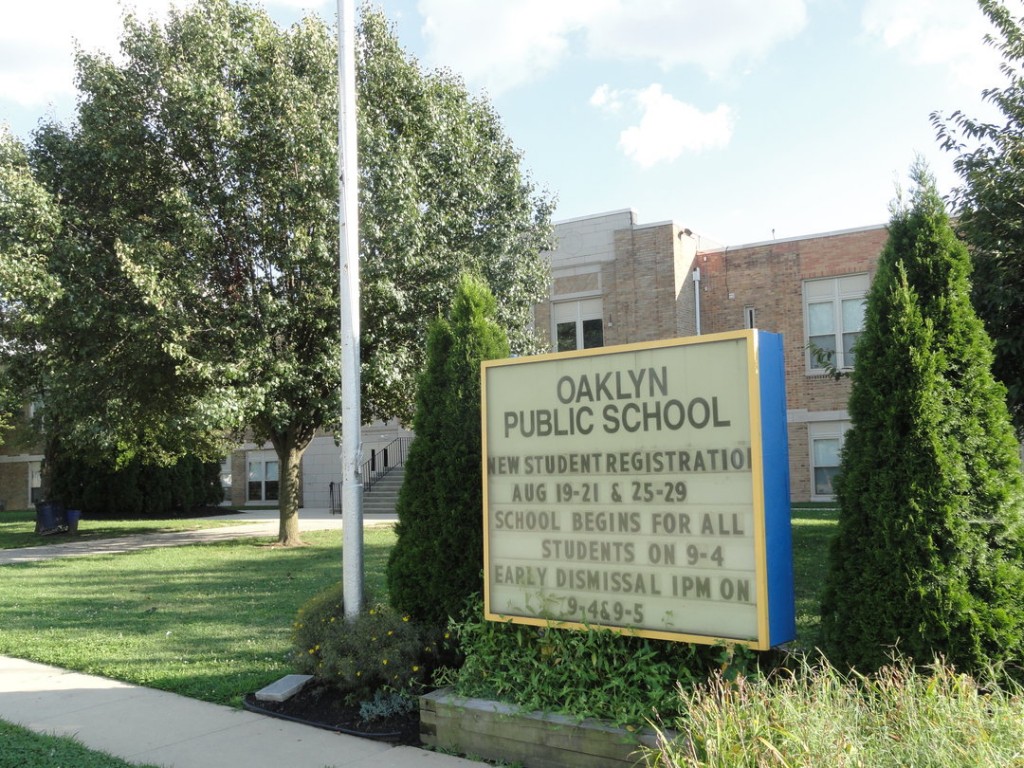Combining the two districts into one could integrate the student experience. It could also cost Collingswood taxpayers and put Oaklyn teachers out of work.
By Matt Skoufalos
With the Oaklyn school district projected to run out of money halfway through the 2016-17 school year, efforts have been underway at the local and county level to devise a plan to right the ship.
One possible result of those dire financial straits could mean merging the Oaklyn and Collingswood school districts.
A new report written by Interim Executive Camden County Superintendent C. Ann Volk examines three potential solutions for the Oaklyn school district, including a full or partial merger with Collingswood or an expanded “send-receive” agreement with the district.
Adopting any of the three choices would mean big changes for both school systems, with an impact to taxes in the neighboring municipalities, staff at the Oaklyn School, and the student experience throughout.
Volk’s report outlines three main options for the Oaklyn school district:
- a full merger with Collingswood public schools
- a partial merger with Collingswood, in which Oaklyn operates its own pre-K through fifth grade school district and grades six through 12 are merged to form a “limited regional district”
- an expanded “send-receive” agreement with Collingswood, in which Oaklyn still operates its own pre-K through fifth grade, and sends students in grades six through 12 to Collingswood
The second and third scenarios offer little opportunity for financial savings or reduction in state reporting requirements because the Collingswood and Oaklyn school districts are already tightly integrated—“essentially operating as one in terms of educational leadership and business management,” Volk wrote.
The report indicates “possible” savings in student educational costs under the formation of a limited regional district, but tuition costs for Oaklyn students under an expanded send-receive relationship would likely increase. Those costs might be offset somewhat by limiting the scope of the district to kindergarten through fifth grade; the Oaklyn School currently educates children through ninth grade.
Under any of these three scenarios, the status of the Woodlynne district would remain unchanged as a sending district to Collingswood.
Any change likely would be decided by a public referendum.
Enrollment and physical capacity
Under the existing arrangements, enrollment in the Oaklyn and Woodlynne school districts, which send their students to Collingswood schools, has been on the decline, Volk wrote.
Since 2010, the number of Oaklyn students in grades 9 through 12 has fallen from 135 to 112 in 2013, and from 187 to 168 among Woodlynne students in the same timeframe.
As a result, the number of Collingswood High School students has fallen in that same period, from 693 in 2010 to 568 in 2013.
The report shows that Collingswood Middle and High Schools have extra seats available for additional students: 292 and 393 seats are available in each, respectively, and that’s with the Oaklyn and Woodlynne students already enrolled in Collingswood High School.
At the elementary school level, however, the district has no room to spare and no plans for build-out; thus any full or limited merger plans would require the district to continue operating the Oaklyn Public School for students in kindergarten through fifth grades.
What a full merger means
Forming a single regional school district to educate Oaklyn and Collingswood students would replace the educational structures of both existing districts and align them under a common curriculum for children educated in pre-kindergarten through 12th grade.
Volk contends in the report that a unified district offers consistent educational policies, helps kids think of themselves as belonging to an overall district with unified goals, and streamlines oversight to one board of education and administrative structure.
“Educational decisions would focus on what would be best for the entire school district program and student body,” she wrote. “The [unified school] Board would need to consider how their decisions would affect elementary, middle and high school students.”
The potential financial savings of such an arrangement could include reduced school board-related expenses, including attorney’s fees, advertising costs, financial oversight, and a single negotiating body for teachers’ contracts.
Dissolving both school districts would require the negotiation of new contracts, however, Volk notes, and “the resulting salary guides would not necessarily be set at the highest rates under the existing agreements.”
Collingswood and Oaklyn currently share a superintendent, Scott Oswald; a business administrator/board secretary, Beth Ann Coleman; as well as technology and professional development programs and some administrative staff.
A unified district would also make it easier for Oswald, Coleman, and their respective staffs to drive efficiencies on everything from textbook purchases to compliance with state policies and even payroll and benefits administration.
“There should be some financial savings in these actions, but the potential key is in the areas of the efficiency and effectiveness of the school district’s operation,” Volk wrote.
Under a regionalized district, the Oaklyn and Collingswood Board of Education would be replaced with a 10-member, interim body selected by Volk. One of the members would hail from Woodlynne; the remaining nine would be from Collingswood and Oaklyn.
In 2015-16, the new board would be elected from among local candidates, with two spots for Oaklyn residents and eight for Collingswood residents.
Then there’s the matter of cost: projections from Volk’s study, which proposes a tax levy based half on district enrollment and half on municipal property wealth, projects a 2.7-percent increase in Collingswood school taxes for the 2016 fiscal year, or $416,061.
Under the same scenario, Oaklyn taxpayers save $14,853.
“This recommendation…will result in the least disruption to existing school district finances,” Volk wrote.
The challenge comes in convincing Collingswood taxpayers that such an arrangement would ultimately be beneficial for their schoolchildren, even if it costs them more money.

Budget figures from Volk’s study outline the possible cost of a merger. Credit: Camden County Executive Superintendent.
A problem of revenue, not expenses
William Stauts, president of the Oaklyn Board of Education, said that there are a number of assumptions in Volk’s study that don’t pan out, including the notion that the financial woes of the Oaklyn school district is a burden shared by Collingswood.
“Two of the three [scenarios] that she uses would cost Collingswood more money than it would cost Oaklyn,” Stauts said.
“It’s not a lot of money—probably $30-, $40-, $50,000 a year for the consolidation—but why would Collingswood spent five cents more to bail out Oaklyn? She’s assuming there’s a problem for the two towns and there isn’t.”
Stauts said that he doesn’t believe Volk’s study “went far enough” in its estimation of financial impact, and criticized it for championing “consolidation, period.
“That may well be her directive from the state, that she’s supposed to get rid of those little districts,” Stauts said. “Our cost per student is lower than Collingswood, than Camden, but we’re supposed to be inefficient.
“We watch every nickel,” he said. “We’ve consolidated just about everything except teachers, where we can’t use a shared services agreement to solve the problem. We also share services with the borough of Oaklyn for the maintenance of the grounds.
“Our cost is pretty low right now,” Stauts said. “We don’t have a problem with expenses. We have a problem with revenue.”
Stauts said that Collingswood likely “would be more than willing” to continue to accept tuition students from Oaklyn, but that such an arrangement wouldn’t necessarily save the financially insolvent Oaklyn district any money.
“If [Collingswood doesn’t] have to hire another teacher, the cost would stay the same but the number of students would increase and the cost per pupil would go down,” Stauts said. “Theoretically, that could result in some savings for Oaklyn; instead of $14,000 for high school, maybe it goes to $13,000.
“The true consolidation, maybe that saves us money, maybe it doesn’t,” he said.
Stauts also spoke about the impact on Oaklyn teachers of shifting the Oaklyn Public School to an elementary-only building. He estimated that the Oaklyn school would lose maybe 15 to 20 teachers by shaving off four grades’ worth of students under a full merger.
Any attrition, however, wouldn’t only be confined to teachers in the higher grades, he said: senior teachers with elementary certification “could bump some of the elementary teachers,” Stauts said. It would be a blow for a district that has produced back-to-back Camden County teachers of the year in 2012 and 2013.
“You might be teacher of the year but you don’t have the seniority that someone else has, and you might be on the outside looking in,” Stauts said.
“The person that’s teacher of the year in Camden County you’d think would be one of the better teachers that you’d want to retain in your district, which we do, but the seniority rights of the other staff would preclude that.”
Asked to guess at the likeliest outcome of the scenario, Stauts said he believes Oaklyn will survive as an elementary-only district under an expanded send-receive scenario.
“I think [a merger referendum] would probably pass Oaklyn,” he said. “The problem I think would be Collingswood. And I don’t blame them.”
Still, Stauts said he believes “some form of consolidation would be better for the kids, because while we share almost everything and our curriculums are very similar, the consolidation would make them exactly the same.
“The parents with school-aged children would probably be willing to pay a penny more in taxes; the others would be less likely,” he said. “The Collingswood board has said they’re willing to consider anything but the Oaklyn board has to come to them with what they want done.”
“Assuming nothing changes,” Stauts said, “I’m going to throw myself on the ground and beg the state for more state aid” to keep Oaklyn operating independently.
Next steps in ‘uncharted territory’
Collingswood and Oaklyn Superintendent Scott Oswald said in an e-mail that following the release of the report at the end of September, the school boards and elected officials in both towns must decide what to make of Volk’s recommendations.
“This is somewhat unchartered territory, so there is no ‘rule book’ for how to proceed,” Oswald wrote.
The superintendent also said that he did not believe the county superintendent would simply “hand down” an order to select one of the options.
“If a true consolidation is considered, my understanding is that would need to be voted on by the residents of both towns and would need to be successful in both towns,” he wrote.
“The decision to go to a referendum/vote would need to be approved by both Boards, but the decision itself would rest with the voter.”
Expanding the existing sending and receiving relationships among both districts would only require the approval of both boards “if we can demonstrate savings going that route,” Oswald wrote.
“Any other scenario will need to be shared by the New Jersey Department of Education, as they have a much better handle on what’s happened in other areas of the state.”
In discussions with the Collingswood Board of Education, Oswald said that the body has two priorities: that the plans must be “tax-neutral or tax-beneficial for Collingswood residents” and “must have a positive impact on student achievement for all students.
“We can make sure the second bullet happens,” he wrote. “Continuity of curriculum will improve if we are all under one umbrella. We are already light years ahead of where we were five years ago, but we still have room to grow. In terms of improving equity and educational quality, coming together makes sense.”
Generating any additional savings from the already administratively well-integrated districts is trickier, Oswald said, because the two already share so much; Volk estimated shared services already save Oaklyn some $600,000.
“As noted in the report, there appears to be no ‘win’ for Collingswood (in terms of taxes),” Oswald wrote. “Over time, I have little doubt we can find additional pockets of savings, but even those, I suspect, will not be great.”
In the meantime, he reported, the Oaklyn district is “sound right now.”
“Teaching and learning continues,” Oswald wrote. “The staff is working hard. I’m sure everyone is understandably nervous about the uncertainty, but our goal is to develop a plan that can be implemented before parents notice any additional decline in services.”







